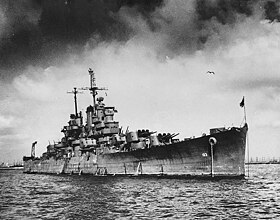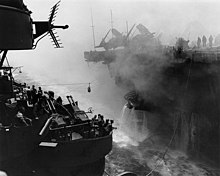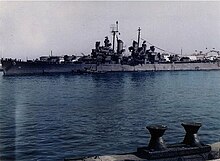USS Wilkes-Barre (CL-103)
 USS Wilkes-Barre (CL-103) at anchor in San Pedro, California, January 31, 1946. |
|
| Overview | |
|---|---|
| Keel laying | December 14, 1942 |
| Launch | December 24, 1943 |
| Namesake | Wilkes-Barre , Pennsylvania |
| 1. Period of service |
|
| Commissioning | July 1, 1944 |
| Decommissioning | October 9, 1947 |
| Whereabouts | sunk |
| Technical specifications | |
| displacement |
11,744 ts |
| length |
186.0 m |
| width |
20.2 m |
| height |
|
| Draft |
7.5 m |
| crew |
1384 |
| drive |
4 boilers, 4 steam turbines , 4 shafts , 100,000 hp |
| speed |
32.5 kn |
| Range |
11,000 nautical miles at 15 kn |
| Armament |
|
| Aircraft | |
| Radio call sign |
November - Bravo - Lima - Whiskey |
The USS Wilkes-Barre (CL-103) was a Cleveland-class light cruiser of the United States Navy . The ship, named after the town of Wilkes-Barre in Pennsylvania , was in service with the US Navy from 1944 to 1947. After its decommissioning, it was sunk during tests in 1972 off the Florida Keys and is now an artificial reef .
technology
For more information on technology, see Cleveland Class
General
The Wilkes Barre belonged to the second, modified series of the Cleveland class. She was 186.0 meters long ( length over all ), a maximum of 20.2 meters wide and had a maximum operational displacement of 11,744 tons with a 7.5 meter draft . The maximum armor thickness was 165 mm on the command tower, 127 for vertical armor and 76 mm for horizontal armor. The cruiser was driven by four propellers, which were driven by four geared turbines with a total output of 100,000 hp. The maximum speed was 32.5 knots , the maximum range at 15 knots was 11,000 nautical miles .
Armament
The main armament of the Wilkes Barre consisted of twelve 152 mm guns, 47 caliber length, which were housed in four triplet turrets. The cruiser was still equipped with the "early" anti-aircraft equipment of the light flak for the second series of the Cleveland class ( Vincennes group ), 20 × 40 mm Bofors (four quadruplets, two twins amidships) and 18 × 20 mm Oerlikon (single mounts), completed. The shipyard tests (inclination) took place in this equipment. On delivery to the US Navy, however, the typical later equipment was available, in which the two Oerlikon in each quadrant on the upper deck on the side of the raised 6-inch towers were replaced with a 40-mm twin each. The war equipment was thus 28 × 40 mm and 10 × 20 mm. It remained unchanged until 1945. After the war, the 40 mm twins were moved amidships to swallow nests at the stern, where the previously existing 20 mm single flak were no longer available (an arrangement that was already common on sister ships during the war). In general, all 20 mm individual flak were removed, including the eight other guns. The bow stands remained empty, the stands across the bridge on the 01 deck were occupied by salute guns , and the four positions around the aft superstructure were given 20 mm twins. The final flak armament was therefore 28 × 40 mm and 8 × 20 mm.
radar
The Wilkes-Barre carried the radar equipment typical for ships of this class from 1944 : SK on the foremast for air search, two SG for sea search, two Mk.8 fire control radars for the 6-inch artillery and two Mk.12/22 combinations for the Fire control devices of the 5-inch guns. This equipment remained unchanged until after the war. It was not until 1947 - practically when it was deactivated - that the SK was exchanged for the SK-2 for air search and the height finder SP was added on the main mast, as was a TACAN system. The ECM equipment that has existed since 1945 has been expanded.
camouflage
When it was put into service, the Wilkes bar was camouflaged with a dazzle scheme according to Measure 32 Design 24D (side surfaces two-tone dull black / light gray, deck two-tone deck blue / ocean gray). The same camouflage design was carried out by numerous sister ships, but mostly in the lighter colors of Measure 33 (such as Astoria , Atlanta , Springfield and Topeka ), only Measure 32 was used for the Pasadena like the Wilkes-Barre . From 1945 the cruiser was painted a single color navy blue (Measure 21) and remained so until long after the end of the war.
history
Construction and commissioning
The Wilkes-Barre was born on 14 December 1942 at New York Shipbuilding in Camden , New Jersey set to Kiel . The ship was christened by Mrs. Grace Shoemaker Miner, the wife of a doctor from Wilkes-Barre, and the ship was launched on December 24, 1943. After further fitting out, the cruiser entered service on July 1, 1944 at the Philadelphia Navy Yard under the command of Captain Robert L. Porter, Jr.
The first practice voyage took the cruiser to Chesapeake Bay and the Caribbean to Trinidad . After completing the “shakedown cruise”, the Wilkes-Barre went into dock again in Philadelphia for smaller jobs. On October 23, she left the shipyard in the direction of the Panama Canal , which was crossed on October 27. After arriving in San Diego, ammunition and fuel were stashed, and after a live gun drill on San Clemente Island , the cruiser set sail for Hawaii on November 10, where it arrived a week later. Before Oahu , the Wilkes Barre took part in two exercises from November 19 to 24 and December 2 and 3 before leaving Hawaii on December 14 for the Caroline Islands . In Ulithi Atoll arrived, she was assigned to the Cruiser Division, the Task Force 38 under the command of Admiral John S. McCain senior should support.
Formosa and Iwo Jima
On December 30th, the association left the atoll and headed northwest. The planes of the task force attacked Japanese positions on Formosa and the Ryūkyū Islands , later they supported the landing troops on Luzon . After a second wave of attacks on Formosa on January 9, the unit ran into the South China Sea to prevent a threat to the landings on the Gulf of Lingayen. On January 12th, the Wilkes-Barre and its sister ships were called Task Group 42.5 by the Fast Carrier Task Force to counter a Japanese threat to Cam Ranh Bay . However, reconnaissance aircraft could not find the reported Japanese ships, so the cruisers returned to Task Force 38 on January 17. On the way back to the task force, the cruisers had to withstand a severe tropical storm that raged in the sea area on January 13 and 14. On January 15 and 16, the aircraft of Task Force 38 attacked Hainan and Hong Kong; on January 21 and 22, Formosa was again the target of the air strikes. The US aircraft carriers Langley and Ticonderoga were damaged during the mission . On January 26, the association returned to Ulithi Atoll. The Fast Carrier Task Force was subordinated to the 5th US fleet there, and Marc A. Mitscher became the new commander of the association . The Wilkes-Barres ran as part of Task Group 58.3 under the command of Admiral Frederick C. Sherman to the Japanese heartland, where on February 16 the air strikes on Honshu and Tokyo began. After two days of air raids on the main Japanese islands, the unit turns south to cover the American landing on Iwo Jima . On February 21, the Wilkes Barre began shelling coastal targets to aid the advance of the U.S. Marines. On February 23, the cruiser and his formation ran north again, to attack Tokyo again on February 25 and Okinawa on March 1. After a refueling stop in Ulithi Atoll from March 5th to 14th, the task force ran north again to attack the Japanese heartland. On March 19, the carrier Franklin was badly hit and had to be towed, the Wilkes-Barre secured with the other ships of the task force the badly damaged ship against further Japanese attacks.
Okinawa

On March 23 and 24, the association's carrier aircraft attacked Okinawa again, and on March 27, the Wilkes-Barre and the other cruisers of the Cruiser Division fired at 17 targets on the Daitō Islands . On March 29, attacks on the Japanese heartland took place again, the cruiser secured the carriers of the task force against air attacks. The Americans began landing on Okinawa on April 1, and the Wilkes-Barre was again part of the security of Task Force 58. On April 11, the association's escort ships fended off a major Japanese air attack, the Wilkes-Barre shot down three Zeke fighters and an Aichi Val dive bomber . The unit moved north to attack the airfields that served as the starting point for the attacks on American ships off Okinawa. Two other Japanese planes were shot down by the cruiser. For the first week and a half of May 1945, the association remained outside Okinawa to support the advancing troops. On May 10, the Cruiser Division 17 and the accompanying destroyers were dispatched to a new bombardment of the Daitō Islands.
The US aircraft carrier Bunker Hill was hit by a kamikaze aircraft on the morning of May 11th , and Wilkes-Barre rushed over to assist with the fire fighting on the burning carrier and to take over the wounded. The wounded were handed over to the hospital ship Bountiful , twelve sailors from Bunker Hill , who died of their serious injuries on board the cruiser, were buried at sea on May 12th . In the following days, the ships were repeatedly attacked by Japanese aircraft, fragments of the anti-aircraft grenades injured on May 14th on the bridge on board the Wilkes-Barre nine crew members. On May 29, John S. McCain took command of the task force again, the cruiser left the association for the Philippines to carry out urgently needed repairs. He remained in the region until June 23, when he rejoined Task Force 38, which began air strikes on the main Japanese islands on July 10. This lasted until the Japanese surrender on August 15th, only interrupted by bad weather in early August.
End of war
On August 27, the Wilkes-Barre was one of the first ships to enter Tokyo Bay . It secured the capture of the naval base in Yokosuka . On September 9, six days after the official signing of the surrender, the Wilkes-Barre was the flagship of the fleet that captured the Tateyama submarine base . The cruiser remained in Japanese waters until the beginning of November and monitored the demilitarization of several Japanese submarine bases. On November 9th he ran to Korea, where he arrived in Inchon on November 13th . On November 16, the Wilkes Barre ran with the destroyers Hart and Bell to Tsingtao to oversee the disarmament of Japanese troops.
On January 13, 1946, the cruiser set course for the United States and reached San Pedro via Pearl Harbor at the end of January . On March 4, the Wilkes-Barre left California for the US east coast, the Panama Canal was crossed between March 12 and 14, and on March 18, it entered Philadelphia. She sailed again on October 20, this time in the direction of the Gulf of Mexico , where she arrived in New Orleans on October 27 to take part in the Navy Day celebrations. Together with the sister ships Dayton and Providence , an exercise then took place in the Caribbean, after which the Wilkes-Barre entered Norfolk on December 13th . On February 17, the cruiser left the US east coast for a trip to Northern Europe, and on February 27, it arrived in Plymouth . The cruiser operated in the British Isles in March and April, and before returning to the United States, she made a brief visit to Bergen in Norway .
Retirement and whereabouts
The Wilkes-Barre was decommissioned on October 9, 1947 in the Philadelphia Navy Yard and transferred to the Atlantic Reserve Fleet . The cruiser remained in the Inactive Ship Facility until it was deleted from the ship's registers on January 15, 1971. The Wilkes-Barre was the last light cruiser to be removed from the US Navy shipping registers. On the way to the scrapping from Philadelphia to Orange , Texas , however, the ship ran aground. It was therefore decided not to continue the voyage, but to use the hull after floating up for experiments with underwater blasting off the Florida Keys. On May 12, 1972, a heavy explosion tore the fuselage in two and the stern sank within a few minutes. The front section was sunk by another explosive charge the following day. The parts of the hull are about 44 to 67 meters deep.
literature
- Lawrence Sowinski: The USS Wilkes-Barre . In: Warship 1/1977, pp. 34-41
Web links
- Pictures of the USS Wilkes-Barre at navsource.org
Individual evidence
- ↑ a b USS Wilkes-Barre in the Dictionary of American Naval Fighting Ships , as of August 28, 2008
- ↑ navsource.org , as of August 28, 2008
- ↑ shipwreckexpo.com: FLORIDA KEYS Shipwrecks USS Wilkes Barre Wreck Key West , as of August 28, 2008


